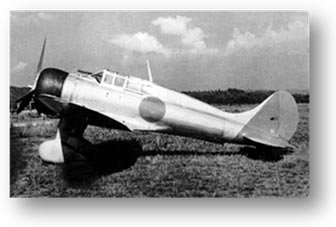The Mitsubishi A5M was the world’s first monoplane shipboard fighter and the direct ancestor of the famous Mitsubishi A6M ‘Zero’. It was a single-seat ship based fighter aircraft developed during the mid-1930s and used during the Second World War, especially as a fighter-trainer. It was in 1934, when the Imperial Japanese Navy specified the requirements for a single seater advance fighter aircraft which could attain speeds up to 350 Kmph at 3,000 m (9,840 ft). The specifications also included the requirements like it should have been able to climb to 5,000 m (16,400 ft) in 6.5 minutes. The Mitsubishi Group of Companies was assigned the task of manufacturing this new aircraft. Dr. Jiro Horikoshi who was the chief engineer behind many Japanese fighters of WWII led the designing team. Allies code named it as “Claude”.
Initially it was designated as Ka-14 by Mitsubishi. Its design was an all-metal low winged. Almost every A5Ms had open cockpits. A closed cockpit was also tried but was discouraged by the Navy aviators. They had a thin elliptical inverted Gull wing and a fixed undercarriage. It was believed that this could result in an increase in performance (estimated as only a 3% increase in maximum speed). Although the use of a retractable undercarriage was not felt to justify the extra weight. The first prototype was powered by a 600 hp Nakajima Kotobuki 5 radial engine which made its first flight on February 4, 1935. The aircraft was finally able to exceed the requirements of the specification. It roared the skies with a maximum speed of 450 km/h (279 mph). The second prototype was fitted with a revised, ungulled wing, and after various changes to maximize maneuverability and reduce drag, the aircraft was finally ordered into production as the A5M.
Early 1937 saw the first use of the aircraft. It was used in the aerial battles at the start of the Second Sino-Japanese War, including air-to-air battles with the Chinese Air Force’. There, they clearly outclassed every aircraft they encountered, though the Mitsubishi team continued to improve the A5M, working through versions until the final A5M5, which added a ventral drop-tank for extended range. A trainer version, the A5M4-K was also built (103 examples). This had twin cockpits and continued in use for fighter training long after the regular A5M left front-line service.
They saw their last war action at the Battle of the Coral Sea on 7 May 1942, when two A5Ms and four A6Ms of the Japanese carrier “Shōhō” fought against the US planes that sunk their carrier. Most remaining airframes were used for kamikaze attacks in the closing months of the war. It had some versions as well. Some of them were named as follows: Ka-14, A5M1, A5M2/2a, A5M2b, A5M3a, A5M4, etc.
Specifications
| Crew: | One |
| Length: | 7.55 m (24 ft 9¼ in) |
| Wingspan: | 11.0 m (36 ft 1 in) |
| Height: | 3.20 m (10 ft 6 in) |
| Wing area: | 17.8 m² (191.6 ft²) |
| Empty weight: | 1,216 kg (2,681 lb) |
| Loaded weight: | 1,705 kg (3,759 lb) |
| Max takeoff weight: | 1,822 kg (4,017 lb) |
| Engine: | 1x Nakajima Kotobuki 41 9-cylinder radial engine, 585 kW (785 hp) at 3,000 m (9,840 ft) |
| Maximum speed: | 440 km/h (237 knots, 273 mph) at 3,000 m (9,840 ft) |
| Range: | 1,200 km (649 NM, 746 mi) |
| Service ceiling: | 9,800 m (32,150 ft) |
| Wing loading: | 95.8.7 kg/m² (19.6 lb/ft²) |
| Power/mass: | 0.34 kW/kg (0.21 hp/lb) |
| Armament: | 2 x 7.7 mm Type 97 machine guns (0.303 in) fuselage-mounted machine guns |
